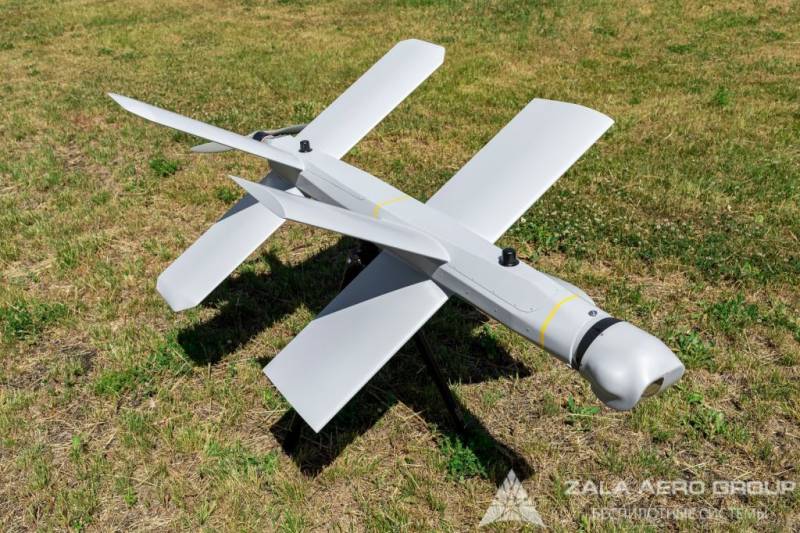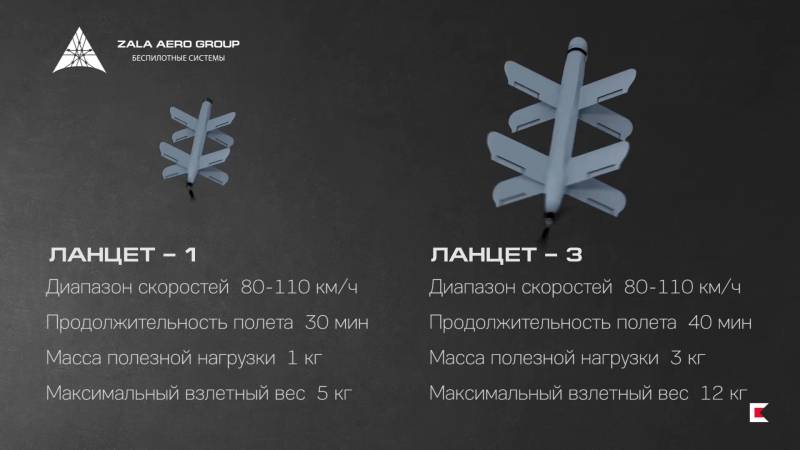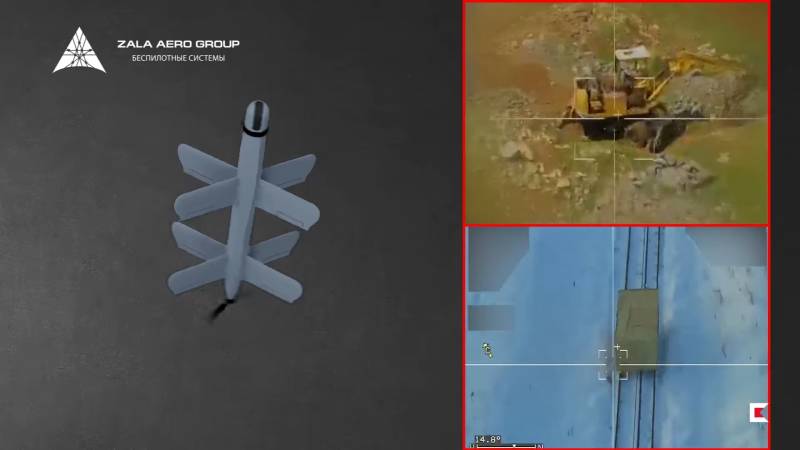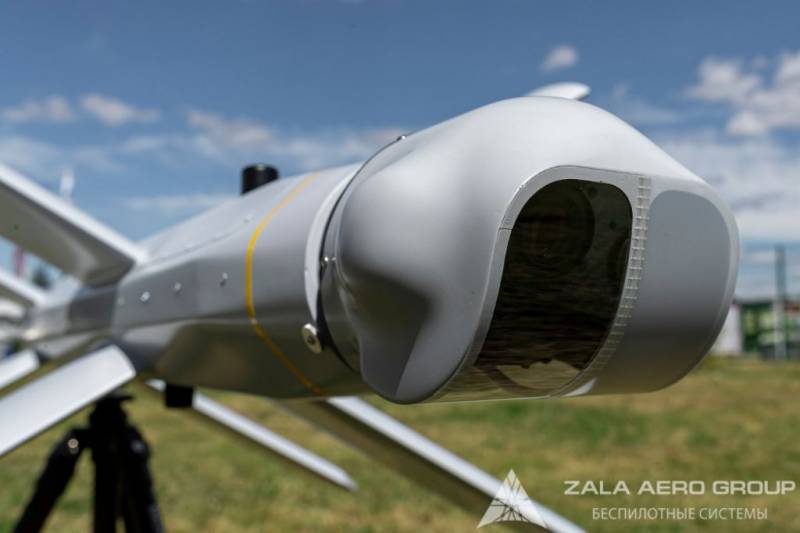Loitering ammunition "Lancet-3"
February 18, 2022 RIA journalists News referring to their own sources, they spoke about the use of new Russian loitering ammunition in Syria, we are talking about a modernized drone-kamikaze from the Lancet family. These loitering munitions are designed and manufactured by the Izhevsk company ZALA AERO, which is organizationally part of the Kalashnikov group of companies.
ZALA AERO specializes in the production of unmanned aerial vehicles, being one of the leading Russian developers in this area. The company's products are used in both the military and civilian sectors. Eg, Drones ZALA are used by the Ministry of Emergency Situations, as well as representatives of Russian business. In particular, drones are actively used to monitor oil and gas industry facilities, surveying more than five million kilometers of pipelines and associated infrastructure every year.
Loitering ammunition has become a relatively new direction for the company from Izhevsk. Currently, the company offers two lines of such devices at once: loitering ammunition of the Lancet family and KUB-UAV. The debut of both strike systems took place as part of the Army-2019 military-technical forum.
What is known about the Lancet-3 complex?
Currently, the Lancet family has two versions of the strike drone. These are loitering ammunition "Lancet-1" and "Lancet-3", which have the same airframe and are similar in the use of some internal systems. The main difference between the devices is their size, which directly affects the combat capabilities and flight performance.
It can be noted that this is a family of scalable devices, so in the future there is a chance to see a more powerful Lancet drone, made according to the same design scheme. Both models - both "Lancet-1" and "Lancet-3" are built according to the aerodynamic scheme of double X-shaped plumage. In an interview with the Rostec State Corporation in 2019, Alexander Zakharov, CEO of ZALA AERO, said that such a scheme on loitering ammunition is their know-how.
According to RIA Novosti, the updated attack drone used in Syria differed from those presented earlier by a modified aerodynamic design. Instead of a symmetrical x-shaped plumage, he received one large x-shaped wing and a smaller x-shaped plumage in the tail. There are currently no photos or renders of the upgraded version of the Lancet-3 in the public domain.
According to Zakharov, the use of X-shaped plumage provides loitering ammunition with advantages when diving at a target and performing maneuvers, and the chosen scheme also made it possible to reduce the size of the product. The devices are really quite compact, the weight of the Lancet-1 model is 5 kg, the maximum take-off weight of the Lancet-3 model has reached 12 kg. Weight reduction is also facilitated by the widespread use of composite materials and plastics in the construction.
Due to the increased size of the Lancet-3, it carries a large combat load. The model is distinguished by increased flight time and the ability to carry a warhead of increased power. The mass of the payload of the loitering ammunition "Laneset-3" has increased from 1 to 3 kilograms. The device is able to stay in the air for up to 40 minutes (“Lancet-1” - up to 30 minutes), developing a speed of up to 110 km / h in flight. In addition, the manufacturer reported that the complex is able to hit targets at a distance of up to 40 km.
The devices received the name "Lancet" not by chance and not only because of their appearance. The main thing is the high accuracy of the devices. A drone can fly tens of kilometers and strike a target with surgical precision. Unlike the KUB-BLAH model, the strike can be observed online, up to the contact of the loitering ammunition with the target. This is achieved due to the presence of a television communication channel on the drone.
The developer's website states that the Lancet-3 complex received several targeting systems: coordinate, with the help of optoelectronic means and combined. At the same time, the drone has a television communication channel that transmits a real-time image of the target and allows you to confirm the success of hitting a given object. On ZALA AERO promotional videos, you can see how the Lancet hits a standing excavator and a mock-up of a target moving along the railroad.
Both devices: both Lancet-1 and Lancet-3 are equipped with electric motors. This is the standard solution for drones under the ZALA brand. The use of an electric motor in this case is not so much a tribute to environmental protection as a guarantee of the inconspicuous use of loitering ammunition. Electric motors are smaller and lighter than their traditional counterparts, and also unrivaled in terms of acoustic visibility.
It is reported that the Lancet complex, in addition to the strike drone itself, also includes a reconnaissance, navigation and communications module. This module is able to determine coordinates from different sources and objects. This is a noticeable difference between the Lancet and many foreign analogues that need satellite navigation. The developers have also worked on the security of the device. It is reported that the "Lancets" received a system of anti-laser protection, which should protect them from modern samples of laser weapons, which is being actively tested as a weapon against drones.
Prospects for loitering ammunition
Loitering ammunition appeared relatively recently. They became widespread only in the 2010s. All such devices are UAVs, which have an integrated warhead of various sizes. Such drones can make long flights over a given area or battlefield, independently detecting a target, and then hitting it from a dive, like guided missiles. The ability of such UAVs to stay in the air for a long time, looking for a target or moment to strike, led to the appearance of the name “loitering ammunition”.
Until a certain point, such developments were ignored in the Russian army. A possible explanation could be the modest strike capabilities of such drones compared to artillery systems. It is possible that the Russian Ministry of Defense considered other tactical schemes: including the use of light reconnaissance drones in conjunction with various strike weapons or heavy reconnaissance and strike UAVs - carriers of their own weapons.
With the latter, the Russian army did not particularly get along, although work in this direction is continuously being carried out. The Orion reconnaissance and strike drone is as close as possible to the start of mass production. Perhaps, against this background, the Russian military showed interest in intensifying work on the creation of their own loitering ammunition, the pioneer in the development of which Israel is considered.
Today, in addition to Israel, the United States, Turkey, China and a number of European states have similar weapons systems. Russia has been added to them, which creates its own line of such systems, counting, among other things, on export deliveries of loitering ammunition. All these models exist in the niche that has taken shape at the moment of relatively affordable means of delivering precision strikes against the enemy.
The range of targets hit by such UAVs is huge. Loitering munitions, which Israel initially developed as a way to destroy elements of enemy air defense systems, can be used to strike at a wide variety of ground targets, both stationary - for example, artillery pieces, firing points, troop concentrations, and mobile - for example, vehicles.
In Syria, the Russian military has already tested the Lancet-1 and Lancet-3, striking at terrorist positions. Similar loitering ammunition was used to destroy militant vehicles on the move, artillery firing positions, and militant firing points. The X-shaped scheme of the Lancet allows it to maneuver effectively, which makes it possible to hit moving objects, such a scheme makes it similar to high-precision missiles.
The advantages of such devices provide them with a cloudless future. One of the most important is low visibility for air defense systems. Small-sized loitering ammunition made of polymer composite materials seriously reduces the possibility of being detected by radar. Such devices are almost invisible to enemy radars.
An important plus is the price of the device, which is almost always lower than standard weapons. Launching a loitering drone is always cheaper than firing a high-precision projectile. In addition to the most high-precision projectile, you must always have at hand also a suitable artillery system with a crew or crew.





Information